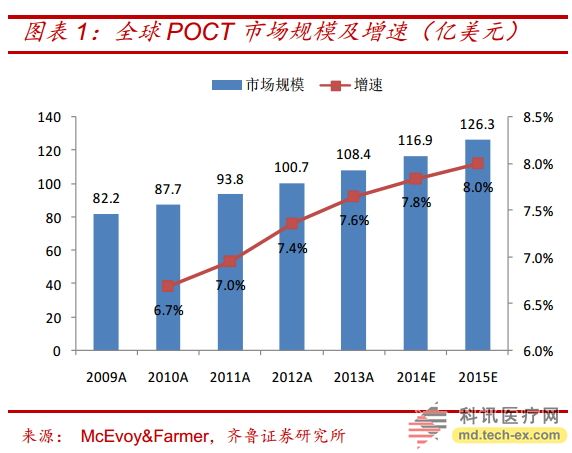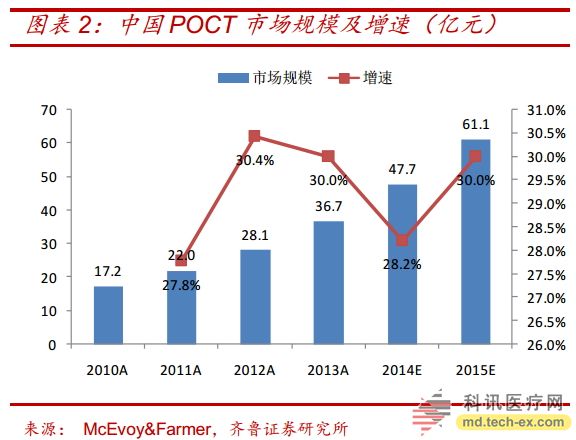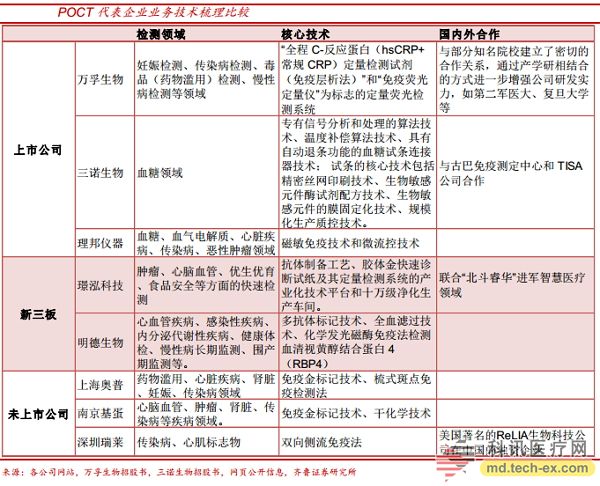POCT Industry Special Report: Rapidly developing IVD segmentation, focusing on technological innovation capabilities
Release date: 2015-09-23

The annual growth rate of China's POCT industry has remained at 20%-30%, far exceeding the world's 7%-8% annual growth rate. POCT (Point of Care Testing) is a sub-industry of the in-vitro diagnostic industry. It is an important development direction and the fastest growing field in the in vitro diagnostic industry in recent years. In 2013, the global in vitro diagnostic market was US$53.32 billion, of which the POCT market was about US$10.8 billion, accounting for 20.3%. The in vitro diagnostic market in China was 26.15 billion yuan, of which the POCT market was about 3.67 billion yuan, accounting for 14.0%. Although it started late, due to the large population of China, the potential market for POCT products is broad, with an annual growth rate of 20%-30%, far exceeding the world's 7%-8% annual growth rate, and also exceeding China's in vitro diagnostic industry. The growth rate of -20% has a large space for development. The "intrinsic value: time + space + operability" and "changes in medical models such as psychology, policy, and disease development" are the main factors driving its rapid growth.


The POCT industry is a technology-driven industry that determines the fragmentation of its segments. At present, domestic enterprises are positioned in different segments of POCT. Most of the sub-sectors have high technical barriers, and their competition mainly comes from imported products. Based on this, we believe that companies with strong R&D capabilities and the first to achieve import substitution will benefit from the rapid growth of the industry.
The different development characteristics of multiple segmentation areas determine the difference in core competitiveness factors.
Mature areas (blood glucose monitoring) have turned to competition in marketing and channels, and growth areas (blood gas electrolyte testing, cardiac markers, pregnancy, infectious diseases, and tumor marker detection) are in urgent need of technological breakthroughs. The following analysis of different segments:
Blood glucose monitoring: The mature segment of POCT, the import/domestic market share is balanced, and the new direction is concerned. Under optimistic circumstances, the total capacity of the blood glucose market in the next five years will be 13.309 billion yuan; in a conservative situation, the market capacity will total 7.072 billion yuan, of which foreign brands occupy most of the hospital market and half of the retail market. At present, the technology of domestic blood glucose POCT has matured and replaced. The effect gradually emerges. We believe that domestic blood glucose meters rely on cost-effectiveness and channel advantages to be more competitive in the home market, while mobile internet, dynamic blood glucose monitoring, and non-invasive blood glucose monitoring are the three main directions for the development of current blood glucose meters.
Blood gas electrolyte testing: The domestic market is about RMB 1 billion, and the growth rate is maintained at around 25%. It is almost completely monopolized by foreign-funded enterprises. Domestic enterprises represented by Libang Instruments account for only about 4% of the Chinese market, due to technical barriers. High, the instrument amount is more expensive, the penetration rate of domestic POCT blood gas analyzer is very low. We believe that with the continuous improvement of medical insurance control fees, mastering the key technologies of equipment portability and creating cost-effective products is an important way to achieve import substitution of blood gas electrolytes.
Cardiac markers: China's POCT heart marker detection market growth rate of about 30%, far exceeding the global 12% compound growth rate, mainly used for rapid quantitative or qualitative detection screening of common cardiovascular diseases (MI, heart failure, etc.) . Roche, Alere, and Mérieux account for about 65% of the market share, and domestic companies have a very low market share. We believe that the future trend of cardiac marker detection is standardized. The key to product competitiveness lies in the number of detection indicators, the length of detection time and the accuracy of detection. There is a big technical gap in the gap between methodologies and batches in Chinese enterprises, and the improvement of technology plays a very important role in improving competitiveness.
Other testing items: the pregnancy market is becoming mature and turning to channel competition. With the liberalization of the national family planning policy, the market for pregnancy-based POCT products still has a certain upside; infectious diseases are new and sudden, and timeliness is enterprise differentiation. The key to competition, in recent years, Ebola, avian flu outbreak, a high demand for rapid detection of new infectious diseases; tumor markers similar to the heart field, late development, urgent need for technological breakthroughs.
In the pursuit of small flowers and strong but not large and complete, the core competitiveness under Moore's Law is the ability of technological innovation.
Domestic trend: localization of POCT products in combination with advanced foreign technology concepts
There are not many listed companies in China for POCT, only Wanfu Bio and Sannuo Bio. Most of the IVD companies have just started to enter the POCT field, such as Kehua Bio, Daan Gene, Yuyue Medical, etc.泓Technology and Mingde Bio franchise POCT; outstanding among the unlisted companies are Shanghai Aopu, Nanjing Base Egg and Shenzhen Ruilai.

Leading foreign companies are doing their best, and deep farming is king.
Just like the traditional in vitro diagnostic industry, the global POCT market is also dominated by leading companies such as Roche, Abbott and Alere. The difference is that these leading companies choose one or several segments of POCT for deep cultivation, in their respective segments. Take the lead. For example, Johnson & Johnson and Roche have an absolute advantage in blood sugar. Alere has strong strength in blood gas, infectious diseases and heart markers. BD focuses on infectious disease POCT, while Abbott uses its versatile i-SATA palm-type POCT. The analysis platform has a place.
Through the analysis of foreign POCT leading enterprises, it can be seen that leading enterprises are deeply ploughed in one or several sub-fields of POCT, and they occupy a leading position in their respective segments. For example, Johnson & Johnson and Roche account for more than 55% of the market for blood sugar. Alere has strong strength in blood, infectious diseases and heart markers. BD focuses on infectious disease POCT, while Abbott uses its versatile i-SATA. The palm-type POCT inspection and analysis platform has a place. We believe that the technical nature of POCT itself gives it a broad space for improvement and a short replacement cycle, and its operability makes it possible to move toward intelligent and mobile. Excellent POCT companies need strong R&D and innovation capabilities to continuously update and create POCT products that are more convenient, faster and more accurate. This allows most companies to focus on only one or several segments.
Remarks: This article is taken from Qilu Securities' research report “POCT Industry Special Report: Rapid Development of IVD Segmentation, Focus on Technological Innovationâ€, Dr. Sun Jian.
Related meeting
2015 (4th) POCT Industry Development Forum
The conference will invite leaders and experts from government agencies, senior managers of domestic and foreign leading enterprises, and clinical laboratory doctors at the top three hospitals in China to discuss POCT policies, regulations, market analysis, technology, products, clinical applications and many other topics. During this period, we will focus on the prospects and development bottlenecks of clinical POCT, the POCT of nucleic acid molecular diagnosis and the new opportunities of POCT under mobile medical treatment. We hope to promote the larger-scale application of POCT and the transformation of new technologies, and provide a communication and cooperation for the industry. platform.
Time: November 19-20, 2015
Location: Shanghai, China
Details: http://
Source: Qilu Securities
Silk Face Mask,Face Mask,Cotton Face Mask,Disposable Flat Face Mask
Puyang Degren Medical Equipment Co., Ltd. , https://www.degrenyuwei.com